
Dimorphotheca sinuata, the glandular Cape marigold, Namaqualand daisy, or orange Namaqualand daisy; syn. Dimorphotheca aurantiaca hort.) is a species of plants native to southern Africa. It is also widely cultivated as an ornamental and naturalized in parts of the United States, primarily California and Arizona.

Calycadenia is a genus of flowering plants in the family Asteraceae, known commonly as the western rosinweeds. They are native to California, especially around the Central Valley. The ranges of two species (C. fremontii + C. truncata) do extend north into Oregon.

Chaenactis is a genus of plants in the daisy family which are known generally as pincushions or dustymaidens.
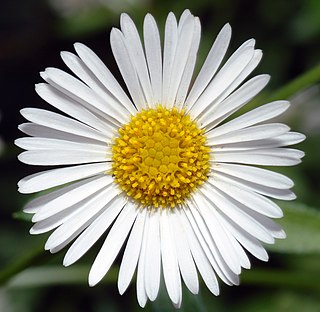
Erigeron karvinskianus, the Mexican fleabane, is a species of daisy-like flowering plant in the family Asteraceae, native to Mexico and parts of Central America.
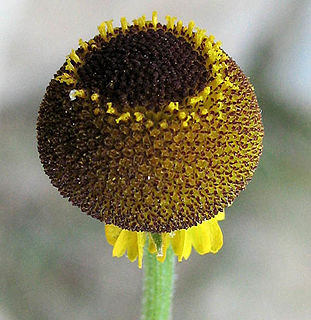
Helenium puberulum is a North American species of flowering plants in the daisy family known by the common name rosilla. It is native to California and Baja California, where it can be found in moist habitats such as riverbanks and meadows. It has also been found in Oregon, although these might possibly be naturalized populations.

Hulsea algida is a species of flowering plant in the daisy family, known by the common name Pacific hulsea or alpine gold. It is native to the western United States.

Layia is a genus of flowering plants in the family Asteraceae known generally as tidy tips, native to western North America. Several are California endemics.

Acourtia microcephala is a species of flowering plant in the family Asteraceae known by the common name sacapellote. It is native to southern California and Baja California, where it grows in woodland and chaparral, especially in the coastal mountain ranges.
Calycadenia fremontii is a species of flowering plant in the daisy family known by the common name Frémont's western rosinweed. It is native to southwestern Oregon and northern California. It is a common member of the flora in several types of habitat in the mountains, foothills, and valleys. This annual plant is variable in appearance.
Calycadenia hooveri is a California species of flowering plant in the family Asteraceae known by the common name Hoover's western rosinweed. It is endemic to a short portion of the western Sierra Nevada foothills, where it grows in rocky areas in the hills along from Amador County to Madera County.

Calycadenia multiglandulosa is a species of flowering plant in the family Asteraceae, known by the common names sticky calycadenia and sticky western rosinweed. It is endemic to California, where it is a common in the Coast Ranges and in the Sierra Nevada Foothills from Shasta County to Kern County.
Calycadenia oppositifolia is a species of flowering plant in the family Asteraceae known by the common name Butte County western rosinweed. It is native primarily to Butte County, California, although a few populations have been found in other parts of the state. It grows in the foothills of the high mountain ranges.
Calycadenia pauciflora is a species of flowering plant in the family Asteraceae known by the common name smallflower western rosinweed. It is endemic to northern California, where it grows in the Coast Ranges north of the San Francisco Bay Area from Napa County to Tehama County.
Calycadenia spicata is a species of flowering plant in the family Asteraceae known by the common name spiked western rosinweed. It is endemic to central California, where is a common grassland plant in the Central Valley and adjacent Sierra Nevada foothills from Butte County to Kern County.
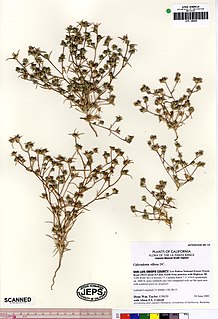
Calycadenia villosa is an uncommon species of flowering plant in the family Asteraceae known by the common name dwarf western rosinweed. It is endemic to central California, where it is known from a limited distribution in the Central Coast Ranges in Monterey County and San Luis Obispo County, with a few populations in Santa Barbara and western Fresno Counties. There are perhaps 16 occurrences.
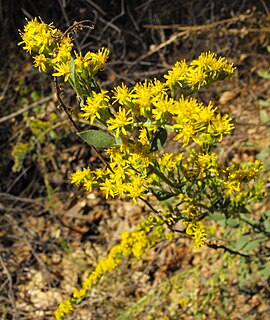
Solidago californica is a species of goldenrod known by the common name California goldenrod.
Calycadenia micrantha is an uncommon species of flowering plant in the family Asteraceae known by the common name small-flowered calycadenia. It is endemic to California, where it is known from about 13 occurrences that are widely spread over several counties, including Napa, Siskiyou, Shasta, Mendocino, Trinity, and Monterey Counties, with several populations known in Lake County. It was described to science as a species in 2004. Some specimens of the plant had previously been included within the description of its relative, Calycadenia truncata. The fact that it has been found in relatively far-flung locations suggests it could easily be present in other areas between them and, as a newly classified species, has simply not been reported yet.

Deinandra fasciculata, known by the common names clustered tarweed and fascicled spikeweed, is a species of flowering plant in the family Asteraceae native to western North America.

Erechtites glomeratus, common name New Zealand fireweed, or cutleaf burnweed, or fireweed or Cluster-headed fireweed, is a species of plant in the sunflower family. It is native to Australia and New Zealand, and also naturalized on the Pacific Coast of the United States.
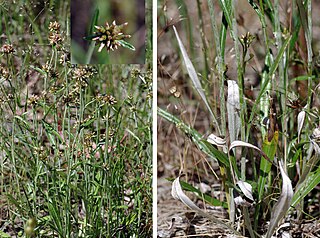
Euchiton collinus, the creeping cudweed, is a herb native to Australia and New Zealand. It has become naturalized in a few places in the United States.













